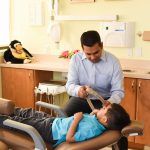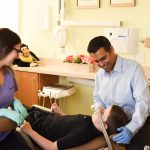Dental Treatment
First Treatment Visit…what to expect
After notifying the administration team of your arrival, you and your child will be asked to proceed into the clinical area. Smiling faces will greet you and your child and the team will try to ensure that your child has a happy and positive visit. Parents are welcome to accompany their young or nervous children for treatment. All treatment steps are introduced in age appropriate and friendly terminology to ensure that children remain comfortable and calm. Our goal is to avoid surprises and discomfort. We try to ensure that each child’s visit is a positive and tear-free one.
- You’re doing a great job!
- Monitoring how Leo is doing
- Leo feeling the squishy magic nose
- Dr. K administering nitrous oxide to Leo
- What are you watching buddy?
- Dr. V explaining to Leo how the “magic nose” will feel
- Dr. V talking to Aiden about the magic nose
- Claire with her soother and the “magic nose” on
- Claire is comfortable, she will take out her soother for treatment
Composite Resin Restoration (Filling):
These are bonded fillings often referred to as “white fillings”. This type of restoration requires moisture control and adequate remaining tooth structure following caries (cavity) removal.
Stainless Steel Crowns:
These full coverage crowns restore a tooth back to function if it has a had a large cavity or pulpotomy treatment (root canal therapy).
White Porcelain Crowns (Zirconia Crowns):
This white full coverage crown is the esthetic alternative to the stainless steel crown. Full coverage of a tooth restores it back to function and is usually required following large caries (cavity) removal and/or pulpotomy (root canal therapy). This type of porcelain crown has limitations and certain indications which will be discussed at the consultation appointment. At Milton Paediatric Dentistry we proudly use EZ PEDO crowns.
Pulp Therapy (Root Canal Therapy in Primary Teeth)
If a tooth has caries that extends to the nerve it may need treatment that is called a pulpotomy or pulpectomy. The pulpal tissue is cleaned out either in the top of the root canal chamber or in its entirety and a medicament is placed followed by a restoration, usually a full coverage crown.
Alternative Restorative Treatment (ART)/Glass Ionomer
Alternative restorative treatment (ART), formerly known as atraumatic restorative treatment, is defined as “a dental caries treatment procedure involving the removal of soft, demineralized tooth tissue using hand instrument alone, followed by restoration of the tooth with an adhesive restorative material, routinely glass ionomer”.2 This technique may be modified by the use of rotary instruments. ART may be used to restore and prevent caries in infants, uncooperative patients, or patients with special health care needs or when traditional cavity preparation and/or placement of traditional dental restorations are not feasible. Although ART has many advantages, it has many limitations as well.
2. Yip HK, Smales RJ, Ngo HC, Tay FR, Chu F. Selection of restorative materials for the atraumatic restorative treatment (ART) approach: A review. Spec Care Dent 2001;21(6):216-21.
Sealants
A sealant is a bonded coating that is permanently applied to the chewing surface (pit and fissure) of molars to prevent plaque, bacteria, and food impaction — ultimately reducing the chance for caries (cavity) formation on those surfaces. This type of treatment is well document and studied and has been shown to tremendously decrease cavities in children and adolescents. After the sealants are placed at Milton Pediatric Dentistry, they are monitored and assessed for retention at every check-up.
The Scientific Evidence on Pit and Fissure Sealants:
Pit and fissure caries (chewing surface cavities) account for approximately 80-90 percent of all caries in permanent posterior teeth and 44 percent in primary teeth.1 A bonded material is placed into the pits and fissures of caries-susceptible teeth that micromechanically bonds to the tooth preventing access by cariogenic bacteria to their source of nutrients,2 thus reducing the risk of caries in those susceptible pits and fissures.
As to evidence of effectiveness, a Cochrane review (one the highest forms of review of all medical scientific research) found that sealants placed on the occlusal surfaces of permanent molars in children and adolescents reduced caries up to 48 months when compared to no sealant.
According to a meta-analysis of 24 studies, the overall effectiveness of autopolymerised fissure sealants in preventing dental decay was 71 percent.4 Another Cochrane review calculated that placement of resin-based sealant in children and adolescent reduces caries incidence of 86 percent after one year and 57 percent at 48 to 54 months.5
Studies incorporating recall and maintenance have reported sealant success levels of 80 to 90 percent after 10 or more years.6,7
1.Beauchamp J, Caufield PW, Crall JJ, et al. Evidence-based clinical recommendations for the use of pit-and-fissure
sealants: A report of the American Dental Association Council on Scientific Affairs. J Am Dent Assoc 2008;139(3):257-68.
2.Simonsen RJ. Pit and fissure sealants. In: Clinical Applications of the Acid Etch Technique. Chicago, Ill: Quintessence Publishing Co, Inc; 1978:19-42.
3.Ahovuo-Saloranta A, Forss H, Walsh T, et al. Sealants for preventing dental decay in the permanent teeth. Cochrane Database of Systematic Reviews 2013;(3)ISSN:1469-493X.
4.Llodra JC, Bravo M, Delgado-Rodriguez M, Baca P, Galvez R. Factors influencing the effectiveness of sealants: A meta-analysis. Community Dent Oral Epidemiol 1993; 21(5):261-8.
5. Ahovuo-Saloranta A, Hijri A, Nordblad A, Worthington H, Makela M. Pit and fissure sealants for preventing dental decay in the permanent teeth of children and adolescents. Cochrane Database Syst Rev 2004;(3):CD001830.18E.
6. Simonsen RJ. Retention and effectiveness of dental sealants after 15 years. J Am Dent Assoc 1991;122(10):34-42.
7. Romcke RG, Lewis, DW Maze BD, Vickerson RA. Retention and maintenance of fissure sealants over 10 years. J Can Dent Assoc 1990;56(3):235-7.









